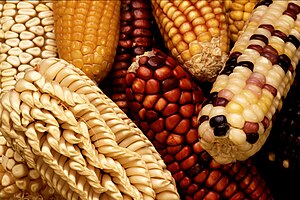| (Photo credit: IITA Image Library) |
In the United States, corn is the leading field crop by a two-to-one margin. We know what corn on the cob looks like. But, this summer picnic staple has a bigger audience than that. Corn is used to produce everything from fuel alcohol for a cleaner burning gasoline, to butters, cereals, soft drinks, and snack foods. It is also grown as feed for livestock.
History
Corn or “maize” has been grown since prehistoric times by some of the earliest civilizations in our world's history. Mayan and Olmec cultures were among the first to cultivate corn in the southern part of Mexico, and the crop began to spread through the Americas by the year 1700 B.C.
When Europeans began to travel to and settle in the Americas, they traded corn with their mother country, and corn began to be a well-known staple of diets around the world. Today, corn is produced on every continent in the world except Antarctica.
Health Benefits
Although there something to be said for limiting your consumption of corn sugars, corn itself does have a healthy side too. Corn's most significant contributions for our health is as a source of vitamins B1, B5, and C, as well as folate, manganese, phosphorus, and dietary fiber. Folate helps reduce the risk of birth defects, heart attack and colon cancer. The B vitamins support memory function which can reduce the onset of Alzheimer's Disease.
A diet rich in whole grains, such as the grain processed from dried corn, (cornmeal for instance) is also generally known to contain phytonutrients that may help ward off disease to our organs and vital tissues. Research has also shown that eating fresh sweet corn can support the growth of friendly bacteria in the large intestine which can help lower the risk of colon cancer. Eating corn has been long believed to add much needed fiber to our diet. That fiber can come from eating sweet corn or cornmeal.
| Genetic diversity of corn. (Photo credit: Wikipedia) |
You can get creative with corn. Of course, dried cornstalks are often bundled and used to decorate homes and businesses during the fall. Also, a corncob can be treated and hollowed out to make pipes for smoking.
Scientifically speaking, the name for corn is “zea mays” which leads us to the word “maize,” the traditional name by which the Native Americans called this crop. However, many cultures throughout the world have cultivated corn and called it by a variation of the word. The colors of corn may surprise you. We normally see sweet corn on the table in shades of yellow, but corn is grown in a variety of colors which include red, purple, blue, and even pink. Some of this corn is strictly ornamental, but some is edible, too.
How to Eat
Choosing a fresh ear of corn means choosing ears that have green husks that are not dried out. You can check the freshness of individual kernels by pressing on them with a fingernail. The freshest corn will emit a milky, white fluid that indicates the corn is at its peak of sweetness and flavor. The husks protect the corn and keep it fresh, so they should only be removed when you're ready to eat the ears you've purchased. I know many stores husk the corn, trim it, and wrap it in plastic. Try to avoid this unless it's your only option - instead look for corn that is still in the husk for optimum freshness and sweetness.
| Fresh sweet corn in husk. (Photo credit: Wikipedia) |
Frozen whole kernel sweet corn is your next best choice after corn on the cob. The corn is picked ripe, then quickly removed from the cob, blanched and flash frozen. The quality may often surpass fresh corn toward the end of the season.
There are a number of delicious cold salads you can make with corn. You'll also find corn adds a wonderful filling taste and texture to many soups, chili, and casseroles. And don't forget the corn products, like cornmeal, cornflour, and other dried corn ingredients we can cook with.
If you are a grilling fanatic, you'll surely want to add corn to your menu. Just remove the silk, keep the husks wrapped tightly and soak in cold water. Remove and place on low grill on indirect heat until you can smell the sweet corn aroma. Remove and baste with seasoned butter for even more savory goodness.
Be sure to check back later this week for more tasty ideas for preparing fresh corn this summer!




No comments:
Post a Comment
We welcome comments and suggestions!